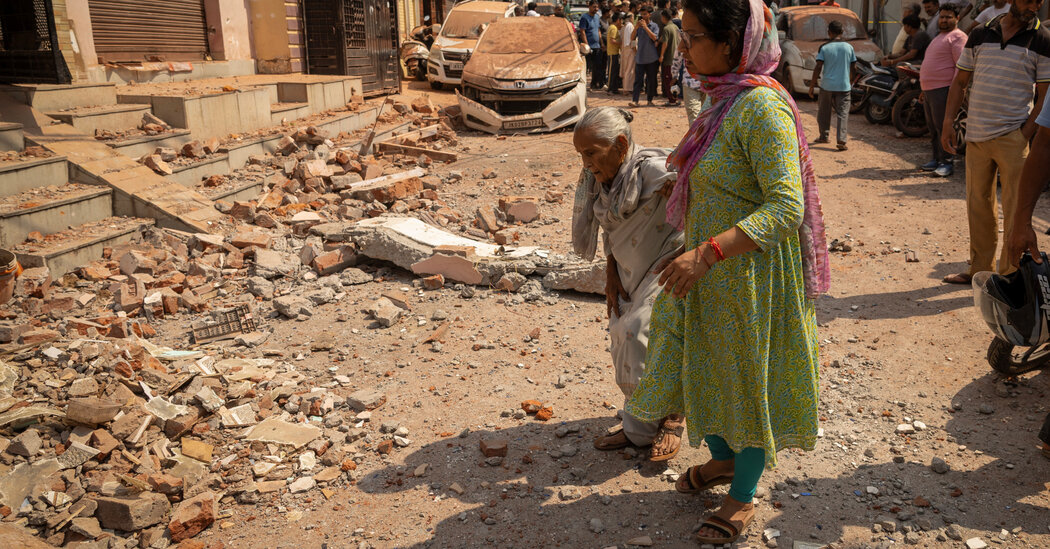India and Pakistan have seemingly pulled back from the brink again. But so much was new about the nuclear-armed enemies’ chaotic four-day clash, and so many of the underlying accelerants remain volatile, that there’s little to suggest that the truce represents any return to old patterns of restraint.
A new generation of military technology fueled a dizzying aerial escalation. Waves of airstrikes and antiaircraft volleys with modern weapons set the stage. Soon they were joined by weaponized drones en masse for the first time along the old Line of Control in Kashmir — hundreds of them in the sky, probing each nation’s defenses and striking without risk to any pilot.
Then the missiles and drones were streaking past the border areas and deep into India’s and Pakistan’s territories, directly hitting air and defense bases, prompting dire threats and the highest level of military alert.
Only then did international diplomacy — a crucial factor in past pullbacks between India and Pakistan — seem to engage in earnest, at what felt like the last minute before catastrophe. In a new global chapter defined by perilous conflicts, distracted leaders and a retreating sense of international responsibility to keep peace, the safety net had never seemed thinner.
“Going back historically, many of the India-Pakistan conflicts have been stopped because of external intervention,” said Srinath Raghavan, a military historian and strategic analyst.
Mr. Raghavan observed that neither country has a significant military industrial base, and the need to rely on weapons sales from abroad means outside pressure can have an effect. But the positions of both sides appeared more extreme this time, and India in particular seemed to want to see if it could achieve an outcome different than in previous conflicts.
“I think there is a stronger sort of determination, it seems, on the part of the Indian government to sort of make sure that the Pakistanis do not feel that they can just get away or get even,” he said. “Which definitely is part of the escalatory thing. Both sides seem to feel that they cannot let this end with the other side feeling that they have somehow got the upper hand.”
The political realities in India and Pakistan — each gripped by an entrenched religious nationalism — remain unchanged after the fighting. And that creates perhaps the most powerful push toward the kind of confrontation that could get out of hand again.
Pakistan is dominated by a military establishment that has stifled civilian institutions and is run by a hard-line general who is a product of decades of efforts to Islamize the armed forces. And the triumphalism of Hindu nationalism, which is reshaping India’s secular democracy as an overtly Hindu state, has driven an uncompromising approach to Pakistan.
On Sunday, there was still no indication that Pakistan or India might repair their diplomatic relations, which had been frosty even before the military escalation, or ease visa restrictions on each other’s citizens. And India did not seem to be backing away from its declaration that it would no longer comply with a river treaty between the two countries — a critical factor for Pakistan, which said that any effort to block water flows would be seen as an act of war.
The spark for the latest fighting was a terror attack on the Indian side of Kashmir that killed 26 civilians on April 22. India accused Pakistan of supporting the attackers. Pakistan denied any role.
The crisis ended a six-year lull in which Prime Minister Narendra Modi’s Indian government had taken a two-pronged approach to Pakistan: trying to isolate its neighbor with minimum contact and to bolster security at home, particularly through heavily militarizing the Indian side of Kashmir.
Establishing a pattern of escalatory military action in response to terror attacks in 2016 and 2019, India had boxed itself into a position of maximal response. After last month’s attack, the political pressure to deliver a powerful military response was immediate.
But the choices for India’s military were not easy. It publicly fumbled the last direct clash with Pakistan, in 2019, when a transport helicopter went down and when Pakistani forces shot down a Soviet-era Indian fighter plane and captured its pilot.
Mr. Modi’s effort to modernize his military since then, pouring in billions of dollars, was hampered by supply constraints caused by Russia’s war in Ukraine. India was also stressed by a four-year skirmish on its Himalayan border with China where tens of thousands of troops remained on war footing until a few months ago.
When it came time to use force against Pakistan this past week, India wanted to put that lost prestige and those past difficulties behind it. It also sought to show a new, more muscular approach on the world stage, able to wield not just its rising economic and diplomatic power, but military might as well.
Western diplomats, former officials and analysts who have studied the dynamics between India and Pakistan said that India came out of this latest conflict looking assertive and aggressive, and perhaps has established some new level of deterrence with Pakistan.
But the way the fight played out did not suggest improvement at the operational or strategic level, they said.
In its opening round of airstrikes, on Wednesday, India struck targets deeper inside the enemy territory than it had in decades, and by all accounts had hit close enough to facilities associated with terror groups that it could claim victory.
Each day that followed was filled with language from both India and Pakistan suggesting that they had achieved what they wanted and were ready for restraint. But each night was filled with violence and escalation. More traditional artillery volleys across the border kept intensifying, bringing the heaviest loss of life. And the drone and airstrikes grew increasingly bold, until some of each country’s most sensitive military and strategic sites were being targeted.
What finally seemed to trigger the intense diplomatic pressure from the United States, with clear help on the ground from the Saudis and other Gulf states, was not just that the targets were getting closer to sensitive sites — but also just what the next step in a rapid escalation ladder for two alarmed nuclear powers could mean.
Shortly before a cease-fire was announced late on Saturday, Indian officials were already signaling that any new terror attack against India’s interests would be met with similar levels of force.
“We have left India’s future history to ask what politico-strategic advantages, if any, were gained,” said Gen. Ved Prakash Malik, a former chief of the Indian Army.
Hari Kumar contributed reporting.


